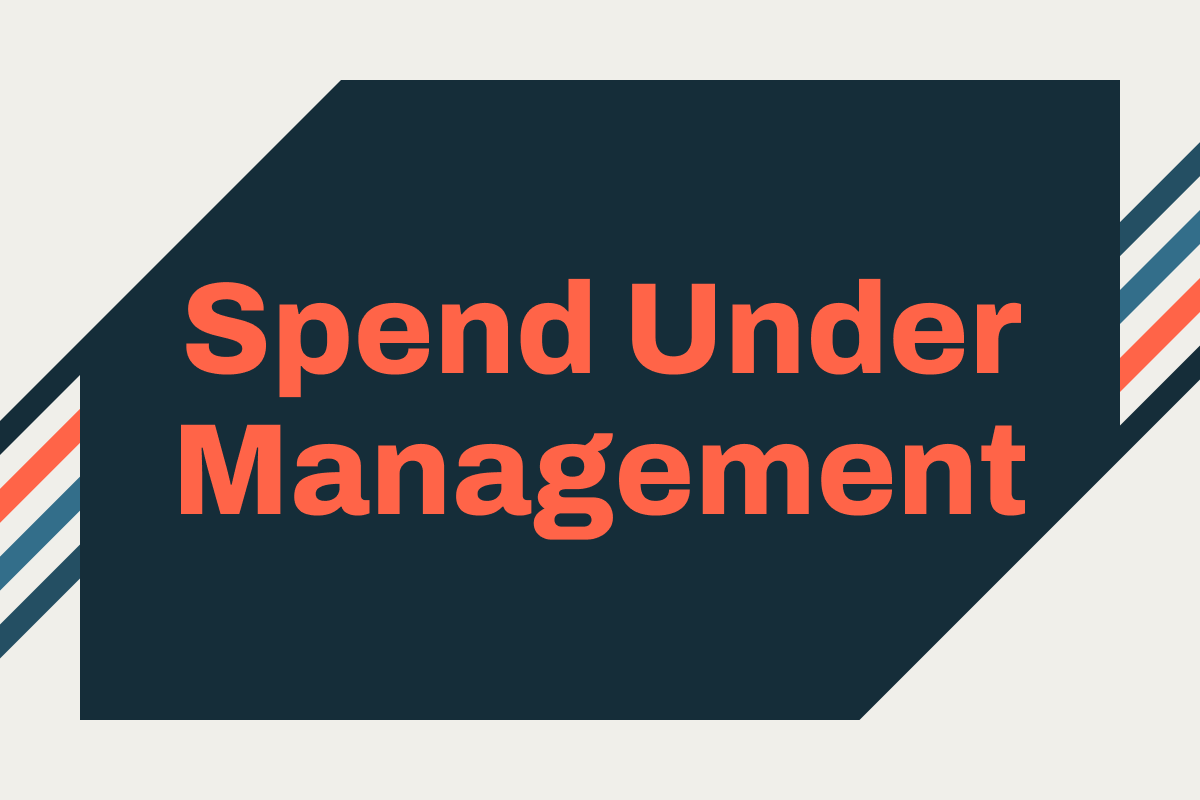As the controller for a 350-person software company, the responsibility to ensure the procurement function is being fulfilled — especially policy compliance, cost control, and vendor management — falls to me. Like many mid-market and early enterprise companies, especially ones that don’t have a lot of direct spend, the decision to staff a procurement department or hire a full-time procurement professional is often delayed.
Even so, there are still steps to help us controllers adhere to procurement best practices without a dedicated team and the legacy systems accompanying them. The first of these is to maximize the amount of spend that we have control over. This is referred to as spend under management (SUM) and is an extremely useful KPI at any stage.
What is spend under management?
SUM is a basic procurement metric that measures the proportion of an organization’s total spend managed through procurement processes. Historically, this has been associated with a centralized process that is overseen by a procurement team. Like many companies of our size and industry, we don’t have a procurement team — but we still need a process to get more spend under management. Central to SUM is to first understand addressable spend.
Addressable vs. unmanaged spend.
Like many companies, the largest part of our spending is decentralized. In this spend model, purchasing is primarily carried out by employees in business units around the globe using corporate cards to pay vendors directly, raising purchase orders for the resources they need, or seeking reimbursements for purchases made with personal funds.
Traditionally, this meant that decentralized spending was unmanaged spend since approvals, documentation, and vendor information were collected after purchases occurred. As a result, there is no real-time control over that spend.
But with new tools, the amount of addressable spend has increased, making the pool of unmanaged spend much smaller.
There are different definitions of addressable spend, which is the spend that can be managed through a procurement process. The most narrow refers to the percentage of strategic purchases with a negotiated price.
A broader definition of addressable spend includes all expenditures except tax payments, charitable donations, employee base salaries and bonuses, dividends, stock repurchases, securities, and organizational memberships.
Modern spend management tools mean I can expand addressable spend to include all sourceable spend, not limiting it to the purchases that procurement professionals strategically source.
When all purchases, corporate cards, POs, and even expense reimbursements are handled through the same intake process before spend is even committed to, decentralized spend is controlled through a centralized procurement process.
Guided Procurement from Airbase automates many of the workflows undertaken by a traditional procurement department, ensuring that documentation requirements are met, coordinating communication across multiple stakeholders, securing approvals, avoiding duplicate purchases, and onboarding vendors. Now, you can access procurement disciplines at a level that classically comes later in a company’s lifecycle.
There are different definitions of spend under management. The most narrow refers to the percentage of strategic purchases with a negotiated price.
A broader definition of addressable spend (the spend that can be managed through a procurement process) includes all expenditures except tax payments, charitable donations, employee base salaries and bonuses, dividends, stock repurchases, securities, and organizational memberships.
Spend management lets me expand addressable spend to all sourceable spend, and not only to the products and services that are strategically sourced by procurement professionals. Once you begin tracking SUM, you can break out what you manage into different categories based on your needs.
Perhaps you’ll track spend by department head more closely or, if you’re a more industrial company, you may break out this KPI to track spend on certain resource materials and so on.
Guided Procurement from Airbase automates many of the workflows undertaken by a traditional procurement department, ensuring that documentation requirements are met, coordinating communication across multiple stakeholders, securing approvals, avoiding duplicate purchases, and onboarding vendors. Now, you can access procurement support at a level that classically comes later in a company’s lifecycle.
How to increase spend under management.
Ultimately, increasing spend under management is not accomplished just with the right people. It is done so with the right systems.
Intake software (like Airbase) that provides a single entry point for all employee purchases is the most efficient way to capture all spend in one place.
That intake process must be configured to automatically route all requests to the right stakeholders to give them oversight before commitments are made. The final test of spend under management is that the stakeholders can influence a purchase before it is made, whether that is lower cost, better terms, or preferred vendors.
Saying you have spend under management is great, but proving it is essential. That’s why today’s tools give you a full audit trail of all sign-offs, where all data and documentation for each transaction is easily accessible from a single platform — an auditor’s dream.
The amazing thing about creating a consistent, low-friction, efficient intake process is that all purchases — from a $30 Uber ride to a $30,000 software subscription — are all managed using the same system and the same pre-approval workflow discipline. It’s just that the software subscription has more stakeholders involved and greater documentation requirements. This complexity can be built in to the approval workflows set for each size and type of spend.
Tools like Airbase make tracking this KPI and getting insights possible. Once you begin tracking SUM, you can break out what you manage into different categories based on your needs. Perhaps you’ll track spend by department head more closely, or you may break out this KPI to track spend on certain resource materials, and so on.
Visibility is the golden key to optimal SUM.
Spend can only be managed if it’s visible. With several stakeholders in the process, there are multiple people that need this visibility. One way to think of it is that procurement is largely a collaboration problem. A variety of stakeholders may need to be efficiently looped in and a lot of information must flow from the purchaser to them.
Airbase’s Guided Procurement workflows integrate with stakeholder business systems, so communication occurs in stakeholder normal operating environments like Jira, Asana, or Ironclad.
It’s not just internal teams collaborating better — vendors enjoy a better user experience with an intuitive vendor portal where they can respond to your customizable vendor onboarding questionnaire.
With Guided Procurement, I have visibility into vendor management and price negotiations, which I can influence before it’s too late. I can also route spend requests to a colleague with specialist knowledge of the vendor pool for particular goods or services if I feel their input would add value.
The system lets me specify rules that reflect our company’s policies, so spend cannot happen until all necessary stakeholders have fully signed it off.
This means that when we do hire a full-time procurement professional, they won’t be wasting their time chasing across an organization to verify that SOC reports have been received, that W-9s are on file, or that agreements have been reviewed by the legal team — the system will enforce all of these requirements.
Companies with a dedicated procurement resource also recognize the value of Airbase’s software. Christina Howlett Perez, Associate Vice President of Procurement at Definitive Healthcare, commented on her experience with Airbase.
“I’m so excited about Airbase’s Guided Procurement! In just a few months from implementation, we tripled our percentage of spend under management, which is an important goal for me as a Procurement leader. The module takes approvals so much further by including all stakeholders in the process — it’s a real upgrade to our internal controls.
“Guided Procurement incorporates everything I need — risk review, privacy review, info security review, and approval review with automatic routing for all relevant purchases. It was really easy to work with the team to design the rules and workflows to reflect our policies.”
Benefits of spend under management.
Getting more spend under management has multiple benefits for organizations.
1. Mitigating risk and financial vulnerabilities.
Close attention to the SUM KPI not only offers favorable savings, but can boost compliance and risk management. When more spend is appropriately managed, there’s a lower chance of fraud, compliance breaches, and unauthorized spending.
For example, one large and mounting risk we see here at Airbase is vendor fraud — our risk team tracks the payments of every single one of our customers. We see firsthand the attempts to defraud companies with doctored or fake invoices. When spend is managed, any changes to, say a vendor’s bank account, are flagged and payments blocked until the change is carefully validated.
Other risks such as zombie spend, where recurring subscriptions simply roll-over on a corporate card even if the product is no longer needed or the employee has left the organization, is eliminated with SUM.
To put it simply, any spend not under management is at risk.
2. Cost optimization.
With more SUM you get more spend data. That makes patterns, supplier performance, and so on, easier to identify and track across a broader range of suppliers and vendors. With more SUM, more of your purchases will be subject to pre-approvals by multiple stakeholders so that costs can be reviewed and better prices or terms negotiated before commitments are made.
3. Improved decision-making.
Increasing SUM improves decision-making by providing greater visibility and control over procurement activities. This helps identify purchases that might be unnecessary or ones with unauthorized vendors. It also allows stakeholders to understand if another solution would be preferable for the organization or if another product already has the sought-after capability.
Even before you have a dedicated procurement team, or a Chief Procurement Officer (CPO), you can now access the best visibility and control. An automated procurement function with Guided Procurement ties procurement into an automated AP function.
4. Improved vendor relationships.
Increasing spend under management helps build better relationships with vendors because when you consolidate purchases with preferred suppliers, you’re more likely to strengthen your partnerships, which can lead to better terms. In my experience, it makes vendor management easier and more strategic, so you can work together more effectively and spend less time on administrative tasks.
SUM is a KPI worth measuring.
The Hackett Group states that world-class companies average 95-97% of total direct spend under management, while other companies typically fall between 66-70%. According to a 2021 survey, the average for all enterprises runs at 63%. Even without a procurement team, I’m consistently tracking at 85-90% and can feel confident that the vast majority of our purchases are subject to our controls and approvals.
As more and more of the business world digitizes and evolves, procurement organizations — and financial leaders like myself — must also evolve their KPIs to reflect digital solution’s broader ability. We have better insights, data, visibility, and control than ever before.
Comprehensive spend management tools are crucial to obtaining that visibility and control, and informing KPIs like SUM. Linking intake to a fully automated accounts payable capability means that, as a controller, I can control the full procure, pay, close process from a single platform.
It’s a no-code, customizable workflow that directs any employee who wants to make a purchase to capture all necessary information and documentation. It routes purchase details to appropriate stakeholders and secures the required transaction approvals.
G2 recently shared that procurement is the last department to catch up with the transition to automated, digitized, and advanced solutions. In the same post, G2 links to the SaaS spend management category, where Airbase ranks #1. I know that Airbase has helped me to get more spend under management but also to track that important KPI.
See how Airbase can improve your SUM. Take a demo today!

Guided Procurement Tour
Explore our automated procurement workflows in the Guided Procurement tour.
 Jira
Jira  Ironclad
Ironclad  DocuSign
DocuSign  Asana
Asana 







